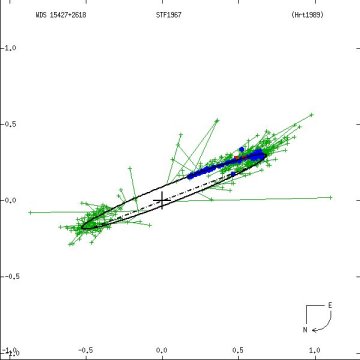
 |
Gamma CrB B goes around Gamma A (the brighter and more massive of the two, placed at the cross) with an orbital period of 92.94 years at an average separation of 32.7 Astronomical Units. North is down, and the scale around the edges is in seconds of arc. Note the closeness of the stars, which are always less than a second of arc apart, making separation difficult and the orbit somwhat uncertain. The dot-dash line is the orbit's major axis. The orbital plane is nearly in the line of sight, resulting in a severe distortion of the elliptical orbit such that Gamma A does not appear anywhere near the focus (where it actually is). When the stars are physically closest together, they actually appear to us to be relatively far apart. In truth, the stars go about each other, orbiting around a common center of mass, which is not determined for this pair. (From W. I. Hartkopf, H. A. McAlister, and O. G. Franz, Astronomical Journal, vol. 98, p. 1014, 1989 in the US Naval Observatory Washington Double Star Catalogue, B. D. Mason, G. L. Wycoff, and W. I. Hartkopf.) |